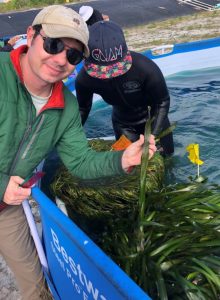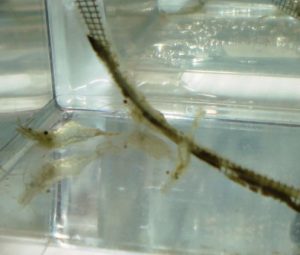Study Provides Insights into Indirect Effects on Food Webs from Oiled Submerged Aquatic Vegetation
– MARCH 28, 2019
Scientists conducted laboratory experiments to assess how oil affects the chemical composition of submerged vegetation (Ruppia maritima) and subsequent effects on how organisms feed on oil-exposed plants. There was a consistent trend of a decreasing carbon-to-nitrogen ratio, by as much as 21%, in grass as oil concentrations increased. This change in plant chemical composition coincided with preferential feeding by grass shrimp (Palaemonetes pugio) and amphipods (Gammarus mucronatus) on plants exposed to higher oil concentrations, which had a higher nitrogen content than did plants exposed to lower oil concentrations. However, when not given a choice between oil-exposed and oil-free plants, the shrimp and amphipods consumed more plant material that had no-to-low oil exposure. The results provide insights into potential indirect effects through subtle alterations of trophic pathways that link primary producers to higher trophic levels.
The researchers published their findings in PLoS ONE: Herbivory of oil-exposed submerged aquatic vegetation Ruppia maritima.
Deepwater Horizon oil impacted over 1700 km of coastal shorelines, including submerged aquatic vegetation that are a critical habitat for many commercially and recreationally important species. Most studies after the spill focused on directs effects on vegetation, but few studies explored how oiling affected the role that submerged vegetation plays as a food source. A better understanding of its role as a food source and the concomitant effects of oil contamination are needed to construct more detailed food web models and habitat linkages and to inform risk assessments for these coastal resources.
Ruppia is an abundant submerged grass with a high tolerance to environmental fluctuations. The research team used Ruppia plant materials from an earlier study that were grown for one month in mesocosms with a range of oil concentrations: none, low (0.26 mL oil/L), medium (0.53 mL oil/L) , and high (1.05 mL oil/L). For this study, the researchers constructed artificial leaves from agar and ground Ruppia tissue and then used the manufactured leaves to analyze feeding choice and foraging rates for shrimp and amphipods, which are abundant herbivores of submerged vegetation.
“We used a variety of choice and foraging rate experiments that have been used frequently in past ecological studies, but until now this approach has not been used to consider the effects of oil,” explained study author Charles Martin. “This experimental approach is useful for assessing impacts on sublethal processes, such as herbivory and predator-prey interactions, which are difficult to measure under field conditions and were not assessed during the spill.”
The results confirmed previous studies that found herbivores prefer nitrogen-rich plants. However, Martin continued, “Surprisingly, we found that oil exposure changed the chemical composition of plants, with higher exposure leading to lower carbon/nitrogen ratios.”
The elevated nitrogen content in oil-exposed vegetation may have driven the preference for contaminated tissues. The results suggest that oil contamination may not be a deterrent for grazers, especially when herbivores can benefit (i.e. meet their metabolic needs) from getting high-nitrogen food. While herbivores had a preference for leaves exposed to higher oil concentrations (higher nitrogen), increased consumption of leaves exposed to lower oil concentrations (lower nitrogen) in the foraging rate experiment may represent a compensatory response for grazers (e.g., herbivores need to consume more tissue to reach the same nutritional and metabolic requirements).
The authors hypothesized that food web impacts may occur as a result of sublethal oil exposure to plants that form a foraging base for the food web. “Simply measuring oil toxicity and other direct impacts is insufficient for understanding the broader impacts of the spill,” said Martin. “In this case, long-term effects of oil exposure could arise due to changes in plant chemistry that affects herbivore feeding patterns, with implications for energy flow throughout the entire food web.”
The researchers suggest that future studies should expand on these lab-based experiments and verify these patterns in the field, where more realistic variables and conditions exist. Additionally, long-term studies that document the mortality rates and sublethal implications for herbivores foraging on oil-contaminated tissues could improve our understanding of the cumulative impacts on coastal environments.
Data are publicly available through the Gulf of Mexico Research Initiative Information and Data Cooperative (GRIIDC) at doi:10.7266/N79G5KBF.
The study’s authors are Charles W. Martin and Erick M. Swenson.
By Nilde Maggie Dannreuther and Stephanie Ellis. Contact maggied@ngi.msstate.edu with questions or comments.
************
This research was made possible in part by a grant from the Gulf of Mexico Research Initiative (GoMRI) to the Coastal Waters Consortium II (CWC II).
The Gulf of Mexico Research Initiative (GoMRI) is a 10-year independent research program established to study the effect, and the potential associated impact, of hydrocarbon releases on the environment and public health, as well as to develop improved spill mitigation, oil detection, characterization and remediation technologies. An independent and academic 20-member Research Board makes the funding and research direction decisions to ensure the intellectual quality, effectiveness and academic independence of the GoMRI research. All research data, findings and publications will be made publicly available. The program was established through a $500 million financial commitment from BP. For more information, visit https://gulfresearchinitiative.org/.
© Copyright 2010-2019 Gulf of Mexico Research Initiative (GoMRI) – All Rights Reserved. Redistribution is encouraged with acknowledgement to the Gulf of Mexico Research Initiative (GoMRI). Please credit images and/or videos as done in each article. Questions? Contact web-content editor Nilde “Maggie” Dannreuther, Northern Gulf Institute, Mississippi State University (maggied@ngi.msstate.edu).







